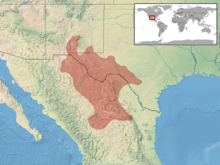Trans-Pecos rat snake
| Bogertophis subocularis | |
|---|---|
 | |
 | |
| Trans-Pecos rat snakes at the Houston Zoo | |
| Scientific classification | |
| Kingdom: | Animalia |
| Phylum: | Chordata |
| Class: | Reptilia |
| Order: | Squamata |
| Suborder: | Serpentes |
| Family: | Colubridae |
| Genus: | Bogertophis |
| Species: | B. subocularis |
| Binomial name | |
| Bogertophis subocularis (A. Brown, 1901) | |
 | |
| Synonyms[1] | |
Bogertophis subocularis, commonly known as the Trans-Pecos rat snake[2][3] or the Davis Mountain rat snake,[4][5] is a species of medium to large, nonvenomous rat snake in the family Colubridae. Bogertophis subocularis is endemic to the Chihuahuan Desert.
Geographic range
The Trans-Pecos rat snake is found in the Mexican state of Coahuila, and its range extends northward into Texas and New Mexico in the United States.[4]
Description
B. subocularis has a row of small scales (suboculars) between the lower border of the eye and the upper labials.[5] This beautiful snake is yellow to tan dorsally with a series of black, or dark brown, H-shaped markings.[2] The eyes are large and prominent, light-colored with contrasting round black pupils. The tongue is pink. Dorsal scales in 31-35 rows. Ventrals 260-277; subcaudals 69-79.[3]
Habitat
The Trans-Pecos rat snake's habitat consists of desert flats and brushy slopes, and rocky outcrops where they nest and feed on small vertebrates.
Behavior
A nocturnal species, it is uncommon and rarely seen in the wild, save on warm summer nights during the breeding season. Nicknamed "subocs" by enthusiasts, they are unaggressive when approached, even passive, and are easily raised in captivity.
Size
Females are larger than males as adults. Adult males reach between 3.5 and 4.5 feet (1.1-1.4 m) in total length (including tail); whereas females grow up to 5.5 feet (1.7 m).[2][3]
Reproduction
The breeding season for B. subocularis runs through May and June, while egg-laying begins in July and ends by September. At nearly three months, their incubation period is lengthy for a snake, at the end of which a clutch of anywhere from three to 11 snakes, each 28–33 cm (11–13 in) in total length, hatch. As they are born during winter, the hatchlings may remain hidden underground for several months before venturing outside.
References
- ↑ "Bogertophis subocularis ". The Reptile Database. www.reptile-database.org.
- 1 2 3 Conant R (1975). A Field Guide to Reptiles and Amphibians of Eastern and Central North America, Second Edition. Boston: Houghton Mifflin. xviii + 429 pp. + Plates 1-48. ISBN 0-395-19979-4 (hardcover), ISBN 0-395-19977-8 (paperback). (Elaphe subocularis, p. 197 + Plate 32 + Map 151).
- 1 2 3 Smith HM, Brodie ED Jr (1982). Reptiles of North America: A Guide to Field Identification. New York: Golden Press. 240 pp. ISBN 0-307-47009-1 (hardcover), ISBN 0-307-13666-3 (paperback). (Elaphe subocularis, pp. 184-185).
- 1 2 Wright AH, Wright AA (1957). Handbook of Snakes of the United States and Canada. Ithaca and London: Comstock. 1,105 pp. (in two volumes). (Elaphe subocularis, pp. 255-259, Figure 79 + Map 23 on p. 223).
- 1 2 Schmidt KP, Davis DD (1941). Field Book of Snakes of the United States and Canada. New York: G.P. Putnam's Sons. 365 pp. (Elaphe subocularis, pp. 152-153, Figure 41).
Further reading
| Wikimedia Commons has media related to Bogertophis subocularis. |
- Brown AE (1901). "A New Species of Coluber from Western Texas". Proc. Acad. Nat. Sci. Philadelphia 53: 492-495 + Plate XXIX. (Coluber subocularis, new species).
- Rhoads, Dusty (2008). The Complete Suboc - A Comprehensive Guide to the Natural History, Care, and Breeding of the Trans-Pecos Ratsnake. Lansing, Michigan: ECO Herpetological Publishing & Distribution. 291 pp. ISBN 978-0978897956.
- Stebbins RC (2003). A Field Guide to Western Reptiles and Amphibians, Third Edition. The Peterson Field Guide Series ®. Boston and New York: Houghton Mifflin Company. xiii + 533 pp. ISBN 978-0-395-98272-3. (Bogertophis subocularis, p. 360 + Plate 45 + Map 150).
- Stejneger L, Barbour T (1917). A Check List of North American Amphibians and Reptiles. Cambridge, Massachusetts: Harvard University Press. 125 pp. (Elaphe subocularis, new combination, p. 84).
- Tennant, Alan (1998). A Field Guide to Texas Snakes, Second Edition. Houston, Texas: Gulf Publishing Company. pp. 200–201.
External links
- Species Bogertophis subocularis at The Reptile Database
